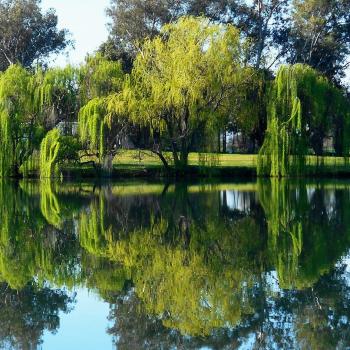Eostre, Goddess of the Dawn
One of the most popular misconceptions about Eostre is that She is a Teutonic derivation of the Babylonian Goddess Ishtar [4]. While Ishtar can loosely be connected to Easter, there is very little evidence that would otherwise connect Her to Eostre. As was discussed earlier, the Spring Equinox was the time for the Babylonian holiday of Akitu, and that part of the festivities honored Ishtar’s marriage to the sky God Marduk. This is significant for Easter because Akitu served as one of the templates for what would become the Christ myth [7][13], but the connection ends there. Connecting Ishtar to Eostre Herself is more of a mental stretch. The only evidence supporting this claim is a devotional shrine to Ishtar (as Astarte) found among the ruins of a Roman fort near Bede’s abby [2]. It is possible that memories of Astarte could have stayed among the local population and eventually corrupted into Eostre, but trying to justify this requires some big leaps of faith. For starters, a single altar to Astarte does not a cultus make. All it proves is that there were one or more Roman soldiers honoring Astarte in the area of Bede’s monastery some 400 years before he wrote De Temporum Ratione.
What is far more likely is that Eostre was derived from the Proto-Indo-European Goddess of the Dawn, *Xáusōs. It is possible to trace “Eostre” to the Proto-Germanic *austrōn (“dawn”) and to the Proto-Indo-European root *aus-(“to shine”). Its also telling that from *Xáusōs it is possible to use comparative linguistics to derive not only the name Eostre, but also the Greek Eōs, Roman Aurora, Vedic Uṣas, Avestan Ušā, and Lithuanian Aušrine [14]. Because we can prove linguistically that Eostre is cognate with this family of Dawn Goddesses, it is likely that Eostre was indeed an Anglo-Saxon Goddess of the dawn.
Development of the Modern Ostara
The folklorist Ronald Hutton describes the development of the modern Ostara as part of his work chronicling the Neo-Pagan Wheel of the Year [1]. The Wicca described in Gerald Gardiner’s original Witchcraft Today(1954) celebrated only six Sabbats a year: the four Celtic Fire Festivals, plus the summer and winter solstices. Gardiner adopted the two equinoxes at the request Doreen Valiente, who wanted to use the solar festivals as a means of concealing her involvement in Wicca from her family [15]. These were treated as minor holidays until 1958, when Gardiner’s London coven requested that they be given equal importance to the other Sabbats.
The creation of a recognizable modern Ostara finally came in 1968, when Aidan Kelly was writing the liturgy for the New Reformed Orthodox Order of the Golden Dawn. Likely drawing on Jacob Grimm’s writings [16], Kelly chose the name “Ostara” for the ceremony and developed for it liturgy emphasizing renewal and rebirth. And the rest, as they say, is history.













